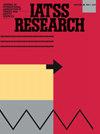An investigation of truck drivers' behaviour before and during real-world advanced emergency braking system interventions
IF 3.3
Q3 TRANSPORTATION
引用次数: 0
Abstract
Advanced emergency braking systems (AEBS) aim to address rear-end collisions, which are the most common crash type involving heavy good vehicles. Although previous studies have investigated the safety benefits introduced by AEBS, there is a lack of research exploring drivers' behaviour before and after AEBS interventions. In this paper, we analyzed 6-s long event-triggered naturalistic driving data, collected from heavy goods vehicles every time an AEBS braking intervention occurred, either as preliminary mitigation braking (pMB) or full mitigation braking (MB). The analyses focused on rear-end critical situations in which the drivers did not brake before a collision warning (CW) or a mitigation braking was triggered by the system. The rear-end critical situations encompassed scenarios where the lead vehicle was the same for the whole duration of the event.
The results show that full mitigation braking are rare events, occurring in approximately 5 % of the complete dataset. Besides, drivers of heavy goods vehicles are in 75 % of the cases already braking before the intervention of CW. Analyzing in detail a restricted number of interventions from CW and MB, it was found that drivers are keeping headway shorter than 1 s in 44.4 % and 53.6 % of the cases respectively. The annotations performed on the restricted dataset indicate that the drivers were “out of the loop” in 57.3 % of CW interventions and 65 % of MB interventions. However, this finding should be taken with caution, due to the lack of video recordings: in fact, the lack of a fast drivers' response could also be an indication of overtrust in the system or a sign of the drivers assessing the situation as not enough critical to require a braking. Further naturalistic driving studies with increased data frequency and availability of video data are recommended to investigate deeper on this matter.
调查卡车司机的行为之前和在现实世界先进的紧急制动系统干预
先进的紧急制动系统(AEBS)旨在解决追尾碰撞,这是重型车辆最常见的碰撞类型。虽然以前的研究已经调查了AEBS带来的安全效益,但缺乏对AEBS干预前后驾驶员行为的研究。在本文中,我们分析了6-s长的事件触发的自然驾驶数据,这些数据是在重型货车每次发生AEBS制动干预时收集的,无论是作为初步缓解制动(pMB)还是完全缓解制动(MB)。分析的重点是追尾紧急情况,即驾驶员在碰撞警告(CW)或系统触发缓解制动之前没有刹车。追尾危急情况包括在整个事件期间领头车辆相同的情况。结果表明,完全缓解制动是罕见事件,约占完整数据集的5%。此外,重型货车的司机有75%的情况下,在连续刹车干预前已经刹车。详细分析了驾驶员的干预次数限制,发现44.4%和53.6%的驾驶员保持车头时距少于1秒。在受限数据集上进行的注释表明,在57.3%的CW干预和65%的MB干预中,驾驶员“脱离了循环”。然而,由于缺乏视频记录,这一发现应该谨慎对待:事实上,缺乏快速的司机反应也可能是对系统过度信任的迹象,或者是司机评估情况不够严重,不需要刹车的迹象。建议进一步的自然驾驶研究,增加数据频率和视频数据的可用性,以更深入地研究这个问题。
本文章由计算机程序翻译,如有差异,请以英文原文为准。
求助全文
约1分钟内获得全文
求助全文
来源期刊

IATSS Research
TRANSPORTATION-
CiteScore
6.40
自引率
6.20%
发文量
44
审稿时长
42 weeks
期刊介绍:
First published in 1977 as an international journal sponsored by the International Association of Traffic and Safety Sciences, IATSS Research has contributed to the dissemination of interdisciplinary wisdom on ideal mobility, particularly in Asia. IATSS Research is an international refereed journal providing a platform for the exchange of scientific findings on transportation and safety across a wide range of academic fields, with particular emphasis on the links between scientific findings and practice in society and cultural contexts. IATSS Research welcomes submission of original research articles and reviews that satisfy the following conditions: 1.Relevant to transportation and safety, and the multiple impacts of transportation systems on security, human health, and the environment. 2.Contains important policy and practical implications based on scientific evidence in the applicable academic field. In addition to welcoming general submissions, IATSS Research occasionally plans and publishes special feature sections and special issues composed of invited articles addressing specific topics.
 求助内容:
求助内容: 应助结果提醒方式:
应助结果提醒方式:


